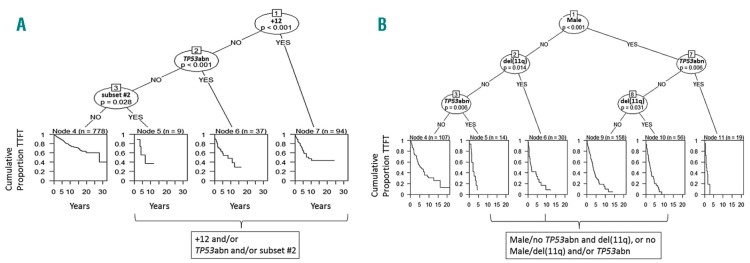Figure 3.
Application of binary recursive partitioning in mutated chronic lymphocytic leukemia (M-CLL) and unmutated chronic lymphocytic leukemia (U-CLL). (A) Decision tree for Binet A M-CLL based on binary recursive partitioning and the subsequent application of an amalgamation algorithm. Trisomy 12 (+12), TP53abn and subset #2 membership were found to be the most significant factors as determined by the partitioning algorithm. The Binet A population is split in 4 terminal nodes (4, 5, 6 and 7). The amalgamation algorithm applied subsequently merged 3 of them in a larger terminal node. In particular, +12 was considered as the covariate with the strongest association to time-to-first-treatment (TTFT). Amongst patients lacking +12, TP53abn was the co-variate with the strongest association to TTFT and so on. After applying the amalgamation algorithm, patients with +12 and/or TP53abn and/or assignment to subset #2 were grouped into a larger node, resulting in 2 terminal nodes. The splitting is performed from right to left, following the criterion of strongest factor association with TTFT. The right branch represents the presence of a particular factor and the left branch the absence of that factor. P-value corresponds to a log-rank scores based test. The Kaplan-Meier curves estimate the TTFT of patients within each terminal node and n represents the number of patients per node. (B) Decision tree for Binet A U-CLL based on binary recursive partitioning and the subsequent application of an amalgamation algorithm. Male sex, TP53abn and del(11q) were the most significant factors as determined by the partitioning algorithm. The Binet A population was split into 6 terminal nodes (4, 5, 6, 9, 10 and 11). The amalgamation algorithm applied merged 3 of the terminal nodes into a larger terminal node. Sex was deemed to be the co-variate with the strongest association to TTFT. Amongst male patients, TP53abn was the co-variate with strongest association to TTFT. Amongst female patients, del(11q) was the co-variate with strongest association to TTFT and so on. After applying the amalgamation algorithm, male patients without TP53abn and with del(11q), and female patients with del(11q) and/or TP53abn were grouped into a larger node. The final number of terminal nodes was 4. The splitting is performed from top to bottom, following the criterion of strongest factor association with TTFT. The right branch represents the presence of a particular factor and the left one the absence of that factor. P-value corresponds to a log-rank scores-based test. The Kaplan-Meier curves estimate the TTFT of patients within each terminal node and n represents the number of patients per node.

